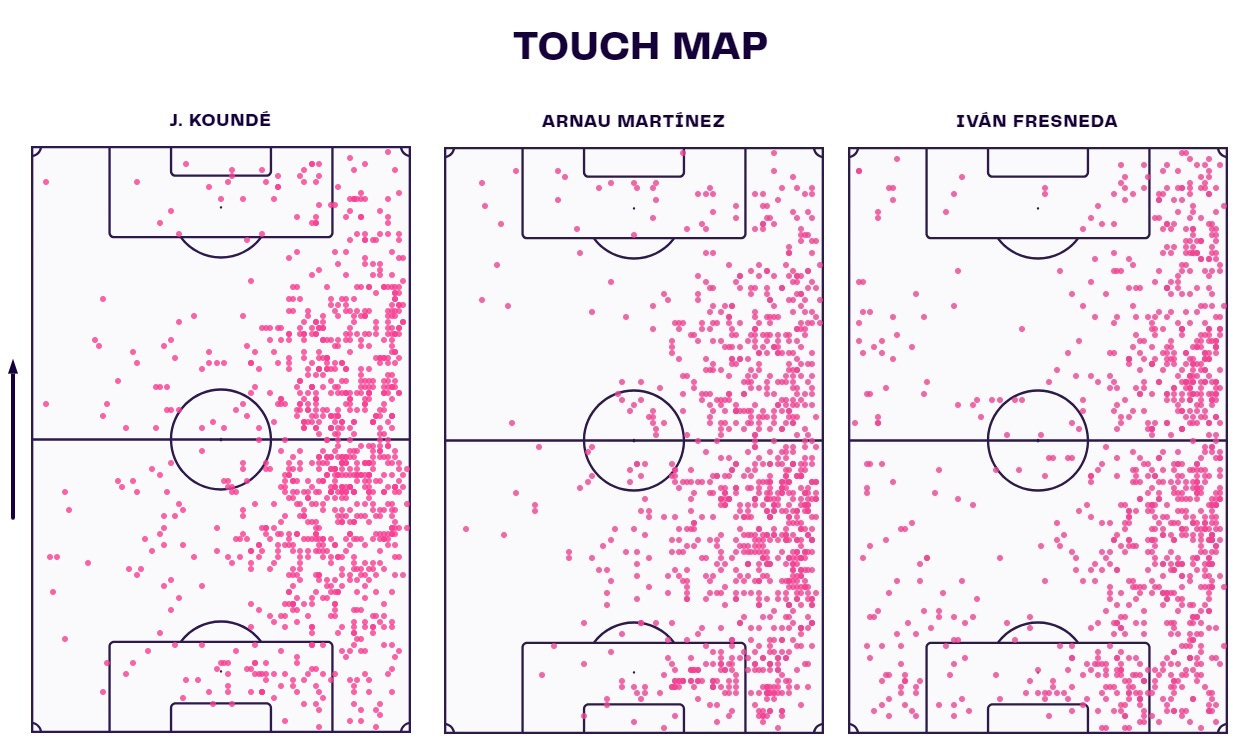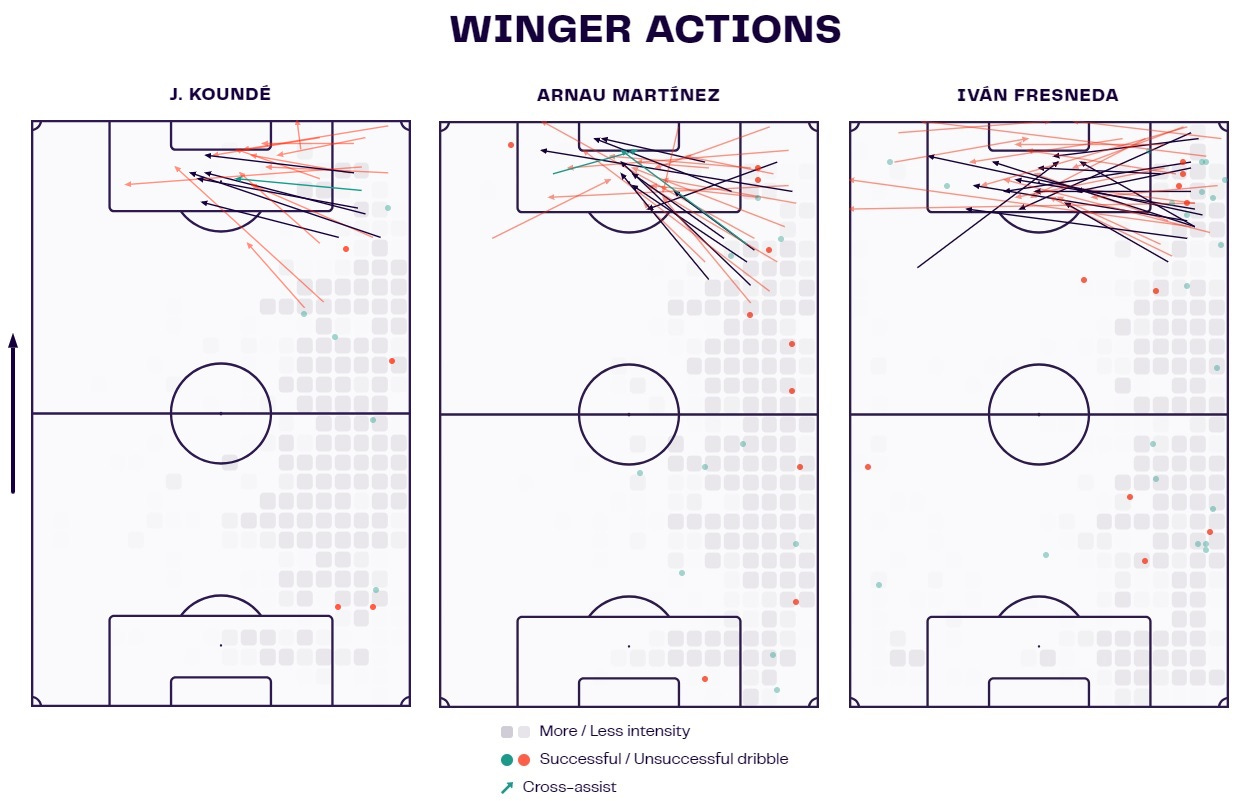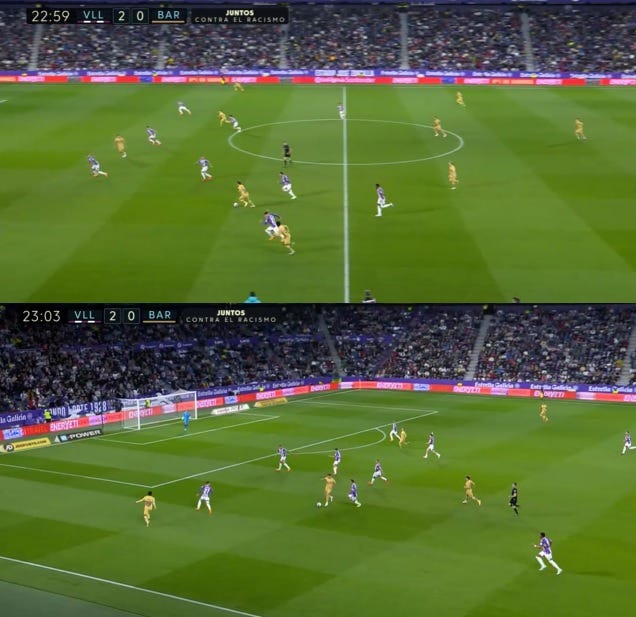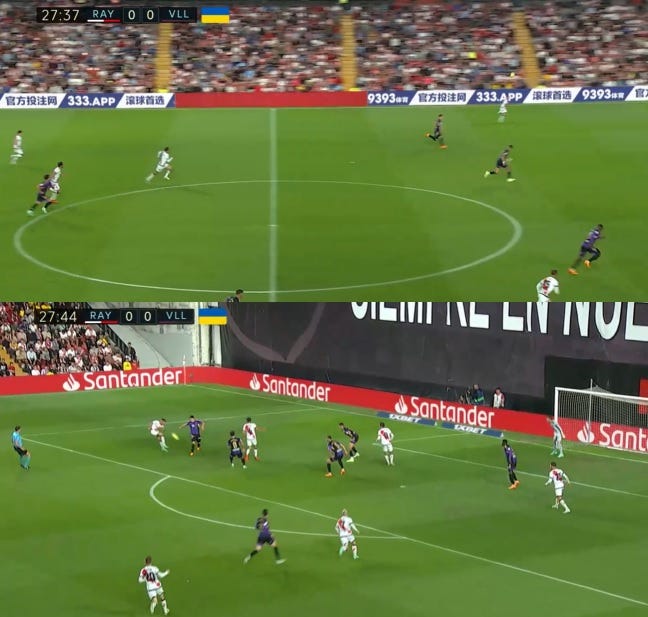Iván Fresneda: The right-back jewel Xavi can't allow to slip away
Fresneda is young and raw. Nothing guarantees his success. Undoubtedly, signing him would represent a risk but his talent is such that missing out on him would be a crime

Barcelona have been looking for a player who could make the right-back spot his own since Dani Alves’ second coming. Many have tried and equally as many have failed. But for the first time in years, there are good options available for Xavi to choose from.
One such option is Iván Fresneda, the 18-year-old Real Valladolid sensation.
However, he is not the only one. Players like João Cancelo, Juan Foyth and Arnau Martínez seem to be heavily linked to the Catalans as well. So who should Xavi choose between those four players?
To me, it’s quite simple; the riskiest but also the most rewarding of them all: Fresneda.
The premise & the Barcelona right-back
Barcelona under Xavi have been using their right-backs in a very specific manner. However, the role’s description is very situational. Against passive, deep-block-oriented teams, a more offensive profile is preferred while against more expansive and aggressive teams, a more defensive profile fits better. But Barcelona currently don’t have anyone who can comfortably fit into the latter (or both) scenario(s).
Someone like Sergi Roberto brings more attacking possibilities but turns the whole right flank into a defensive liability. Ronald Araújo takes care of the defensive aspect but doesn’t move the needle offensively. That often leaves us with Jules Koundé, the player best equipped for the job. His high defensive efficiency and great distribution on the ball make him suitable for the assignment but the player himself doesn't feel comfortable in that role and prefers a more central position in the backline. Similarly, while Koundé is good on the ball, he is not creative (enough) nor can he provide a major attacking boost for the team.
But considering he’s the only real option Xavi has, the right-back role has largely been used in a supportive manner, reflective of Koundé as a player; an inverting, often passive function which aids the build-up, distributes the ball and provides protection behind mirrors the man playing there. But the profile of the right-back also depends on the profile of the winger - a lot.
Someone like Ousmane Dembélé needs a player of Koundé’s mould behind him; someone to cover for his chaos and clean up his reckless nature. But someone like Raphinha, who doesn’t command the whole flank and is more of a minimal-width inverting presence, would be better paired with a more adventurous profile right-back. This puts Barcelona in an unenviable position.
It’s quite clear the profile of that right-back depends on multiple factors and they can either have two different players for two general situations or a single two-way player who can play in both scenarios. The rough requirements for that player would be as follows:
- Defensive capability (protective, solid in rest defence, able to track back, 1v1 specialist, CB/RB-hybrid)
- Two-way full-back (invert/form an auxiliary double-pivot, overlap)
- Build-up contribution (recycling, progression, distribution)
- High technical level (press-resistance, tight-space manipulation)
- High physical level (athletic, strong, stamina)
Undoubtedly, we’re talking about a complete player; a rarity in that position. But which one of the options listed above, if any, tick these boxes?
Iván Fresneda: Player profile
Fresneda is an 18-year-old right-back currently playing for the relegated Real Valladolid. He stands at 182cm (6'0'') and weighs 73kg (160 lbs), boasting a broad build with long legs. We’re talking about a young player at the beginning of his professional career and as such, Fresneda is still raw. However, he boasts both a high floor and a high ceiling.
From a purely physical standpoint, the 18-year-old commands an impressive presence on the pitch, showing exceptional pace, strength and stamina. He is right-footed and generally relies on it for passing, control, shooting and carrying. When it comes to his technical skill, Fresneda is very much a two-way full-back.

Above, you can see his statistical profile, kindly provided by TotalFootballAnalysis. The numbers have been compared to all other right-backs in the top tier, showing us Fresneda’s great foundations but also confirming he’s still very raw across the board. However, even at the age of 18 and playing for a team that just got relegated, he was still able to impress.
He is an excellent defender first and foremost, utilising a mix of physicality and skill as well as reading the game quite well at this stage of his career already. On the ball, he’s able to invert into the midfield or play as the third centre-back in a back three. His passing is safe but can be expansive as Fresneda boasts excellent ball-striking for crosses and long distributions.
Similarly, he has the pace, dribbling and a high technical basis to manipulate the ball well in tight spaces, overlap and link up in the final third. His end product, however, is still inconsistent and is an area that needs to be further polished for the highest tier of football.
On the ball
Considering Barcelona are currently monitoring several players for this position, we’ll compare Fresneda to both Koundé and Arnau. The reason I’ve decided to exclude Cancelo and Foyth is purely the financial aspect; their price tags make them unattainable at this very moment. However, even if that weren’t the case, the conclusion of this analysis would largely be the same.
With that out of the way, let’s first tackle each player’s role within their respective teams. Barcelona are by far the most ball-dominant of the three teams, followed by Girona and then closely by Real Valladolid. Interestingly, all three registered more than 50% of possession in 2022/23, albeit both Girona and Valladolid struggled to do so consistently.
Naturally, much greater possession yields far more pass volume so Koundé is the player that sees more of the ball compared to the other two players. That said, looking at their respective touch maps, we can see their tendencies are quite similar.

All three players seem to be fairly comfortable going both ways but with minor differences. Koundé, for example, spends much more time tucked into the right half-space in the middle third of the pitch, Arnau stays deeper and wider more often and Fresneda generally sticks wide in the middle third for Real Valladolid but also spends the most time very high up, deep in the opposition’s half.
Which one of those would best suit Barcelona’s needs? Essentially, all three fit certain scenarios. Koundé’s profile, despite his preferences lying elsewhere, fits into that supportive distributor mould. Arnau is similar but with a much deadlier final ball while Fresneda seems like the best of both worlds; a protective supporter with good distribution and tools to destabilise the defensive block, albeit via different tools.
One of the main criticisms of Fresneda’s signing is aimed at his (lack of) propensity to invert and form an auxiliary double-pivot. However, despite his initial wide positioning in the middle third, the 18-year-old is perfectly capable of tucking inside and forming the box alongside the pivot and the two centre-backs.

This is especially true when he’s playing for a far more possession-dominant Spain U19 team, which is an even better indicator as they mirror the Barcelona way of playing more than Real Valladolid do. In that system under José Lana, Fresneda often inverts into the midfield, occupying the highlighted area in the second and third phases of attack. He does it for Valladolid too but less often and there, it’s far more situational.
Still, due to his high technical basis, he’s able to comfortably slot into the midfield and distribute or disrupt from there, depending on the role given to him. Fresneda is very right-footed though and this could pose a problem both in his link-up angles and the initial movement from out to in, especially on the ball.
The issue with leading with his right foot when cutting inside from right to left is that the ball has to go across the body, giving the marker more openings for a tackle. Similarly, the right-midfielder role may require him to use his left foot more in certain scenarios too. It’s not a necessity but it would make things far more easier for him.

Above you can see an example of his wide starting position and then the tendency to invert into midfield following a link-up play. This is quite interesting because it shows us the theoretical relationship between him (right-back), the right centre-midfielder and the right-winger at Barcelona. His tucking in gives more central options and provides a disruptor or a retainer down that channel.
Fresneda is agile and capable in tight spaces, explosive over short distances and can manipulate his body and the ball well, meaning the crowded central areas don’t frighten him much. But what about his passing and recycling ability in a stable phase of possession?
Compared to Koundé and Arnau, he registers fewer received passes, fewer overall passes per 90 and fewer progressive passes per 90. However, the difference between him and Arnau is almost negligible, usually coming down to a pass (or even less than a single pass) per 90 minutes. Koundé, though, registered more than double both their tallies in 2022/23 but that is a direct reflection of Barcelona’s ball dominance over Girona and Real Valladolid respectively.

Interestingly, Fresneda is on par with both of the other two players when it comes to progressive passes per 90 and even beats Arnau in progressive runs. It has to be noted that he is at least in the top 30 right-backs in LaLiga across all of these mentioned categories; quite a feat for a raw 18-year-old playing for one of the worst teams in the Spanish first division.
Above, we can see their progression graphs, including passes, runs and dribbles. It does seem Fresneda is more of a runner when it comes to progression but interestingly, while he comes fairly close to eclipsing both other players’ passes into the final third per 90, he straight-up outperforms them when it comes to passes into the penalty area. It’s also interesting to note how they progress and distribute the ball.
Koundé and Arnau are fairly similar in their execution, often starting from the middle third and then delivering passes either directly from there or from that right half-space in the opposition’s half. In that regard, Arnau is like a more deadly and creative Koundé; able to mirror his role with an extra edge to his final ball. Fresneda is different. His distribution is either long from the deep or in the form of crosses from very high positions.

These are examples of his distributions, generally finding runners through the half-space from deeper areas of the pitch. This is key as we know half-space penetrators are one of Xavi’s non-negotiable tactical aspects. Generally, Fresneda’s long balls are longer than both Koundé’s and Arnau’s but he doesn't rely on them more than the other two. All three players have it in their locker to be the middle third distributors but Arnau is the one with the most creative arsenal, almost topping the LaLiga right-back charts in shot assists per 90 and expected assists per 90.
However, Fresneda’s potential on the overlap is much higher. He runs in big strides and has a lot of pace, meaning he can cover a lot of ground and is very difficult to stop once he gets going. The data showed us he likes to deploy crosses from high positions and deploys more than both Koundé and Arnau, albeit with a worse success percentage than the latter player. But when you pair that up with his superior dribbling, acceleration, carrying, pace, successful attacking actions per 90 and deep completed crosses per 90, you get a player with a frightening offensive ceiling.

The winger actions confirm what was said already: Koundé and Arnau are (somewhat) similar in their distribution while Fresneda is more aggressive in his approach, occupying higher zones and delivering more crosses. He is also a player who’s more intense in the wider areas across the pitch while the other two spend more time in their respective half-spaces.
It’s also quite interesting to see that Fresneda likes to dribble in the deeper areas and is quite successful at it too; this shows us his capability to turn into a much more complete press-resistant player who can carry or distribute the ball forward once he frees himself of his markers. Higher up the pitch, that dribbling ability is best paired up with his pace and delivery into the penalty area.
You can see such examples down below.

These two samples show us two different phases: one is a settled phase of attack where Real Valladolid push Fresneda high and wide to deliver crosses into the box and the other is a transition, where Spain U19 use Fresneda’s pace on the overlap to attack space.
While his final product isn’t necessarily as polished as Arnau’s, he provides attacking value in different forms, replacing a vital part of running power, dribbling and pace Barcelona lost with Dembélé’s departure. They don’t need another creative passer next to Raphinha, they need a more aggressive, higher and faster presence to complement him or Lamine Yamal.
And Fresneda is exactly that.
Off the ball
While the attacking phase shows Fresneda is a player to watch out for, the defensive phase is where he already stands out. As mentioned already, this proficiency is brought about by a mix of two crucial factors: physical attributes and skill.
Again, team context is very important here. Real Valladolid finished their 2022/23 as one of the three worst teams in LaLiga, getting relegated as a direct result of that. It doesn't surprise then that they are the team that faced the most shots and conceded far too many goals along the way. This, inevitably, impacted the stats too.

Of all three players, Fresneda is the one with the most defensive duels, most successful defensive actions, most shots blocked and most possession-adjusted interceptions. Quite clearly, of the three players, he is the most established defender and also covers the most territory as well, as can be seen in the graph above.
Fresneda’s defensive actions can be traced all across the first third of the pitch and they also span very high up, albeit with a slightly deeper defensive line. Koundé is the one who plays in the team with the highest defensive line but also with the most aggressive press. Girona’s defensive line is slightly higher than Real Valladolid’s but they’re not as intense in their press. So there’s a mix of different team approaches here which inevitably impact the stats.
Interestingly, when it comes to high regains, Arnau is the most effective of the three despite playing for the least aggressive side.

But one thing that separates Fresneda from the other two candidates is the pure athletic aspect. His stride length and general build give him an immense advantage in tracking back, duelling, covering a lot of space quickly and shielding. It helps, too, that the 18-year-old knows how to use his frame reasonably well.
This is most evident in his tackling and shielding. The latter, of course, is inherently an offensive trait but lends itself nicely to duelling too. When challenging for the ball, Fresneda’s long legs give him reach and mean he can snatch or simply kick the ball away from awkward angles, often around the opponent’s body. In possession, they give him a wider protective radius and when paired up with his agility and technical nature, it results in aesthetically pleasing twists and turns as the 18-year-old wiggles out of tight spaces.
An example can be seen below.

One thing I have noticed in these tackles is that he can sometimes be hesitant. Data suggest a large volume of duels but Fresneda is not always fully committed to his tackles and won’t always take the initiative. This doesn’t necessarily have to be a bad thing, especially considering when he does engage, he’s generally quite successful, but it’s a trait that can be taken advantage of.
Lastly, however, we have to discuss his pace, stamina and reading of the game. We’ve already covered his physical attributes but pace is an important aspect of both Fresneda’s attacking and defensive profile. In attack, it can be used for overlaps and progressive carrying while in defence, it’s mainly used to track runners and cover space.
Here’s a great sequence showing his speed against Barcelona’s fastest player, Alejandro Balde.

Even though it’s generally more difficult to analyse speed through images, we can see both their starting and finishing positions. Notice how Fresneda kept up with Balde and wasn’t left behind even in a direct foot race against the young left-back. But this is best utilised when combined with the 18-year-old’s reading of the game.
Naturally, as he is still very young and raw, decision-making will come with more experience but simply by comparing his shots blocked and interceptions with the other two analysed players, we get a clearer picture of his sense of positioning. And considering he bests both of them in pure data, this bodes well for his defensive prowess.
Here’s an example where we can see his pace and reading in action.

Again, we find Fresneda in a foot race against the attacker and not only does he manage to catch up but also registers a vital block inside the penalty area. The only real deficiency in his defensive repertoire are aerial duels, which he seems to be struggling to win despite his reasonable height and power, and his indecisiveness in tackling.
The rest is at an already high level and can get better if he keeps working and progressing.
Final remarks
Considering Fresneda ticks all the boxes under the conditions we mentioned at the beginning of this scout report and considering his price tag, high floor and even higher ceiling, this transfer is a no-brainer.
Arnau is also an excellent choice but gives Barcelona less versatility in attack. He’s very similar to Koundé in the way he occupies space and the areas from which he distributes but has much more edge and creativity in his repertoire. However, a pacey disruptor who can confidently overlap and cross while also being able to invert, play as part of a back three and stay wide if necessary is a much better fit for Xavi’s structure.
Fresneda is young and raw. Nothing guarantees his success. Undoubtedly, signing him would represent a risk but his talent is such that missing out on him would be the far worse crime. Especially considering Barcelona really need a cheap and yet long-term quality signing.
Pull the trigger, Laporta




